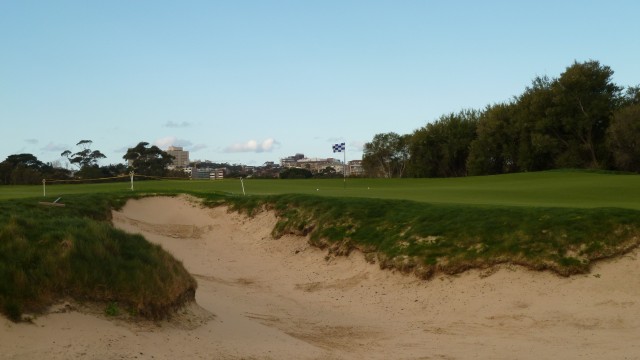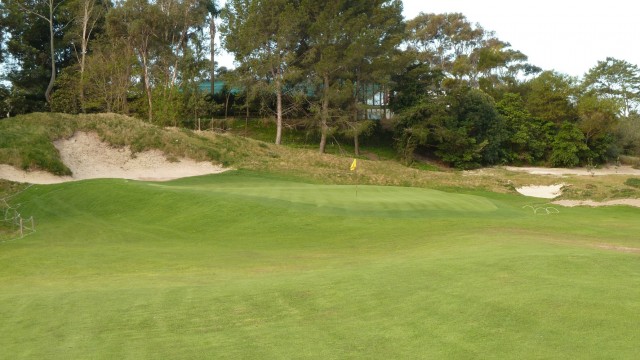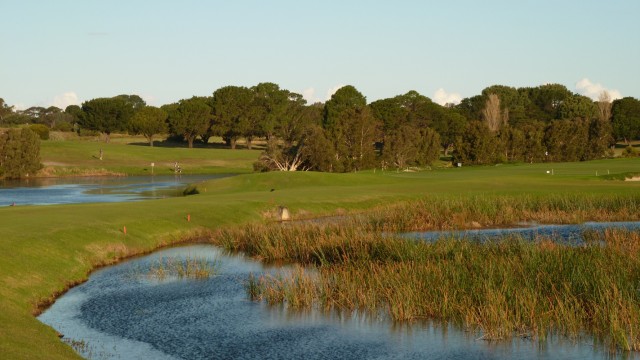
Location: Mascot, NSW
Established: 1928
Architect: Bruce Devlin & Robert von Hagge (1967)/ OCCM (2009)
First Played: 7th Sep 2010
Last Played: 30th Dec 2021
Magazine Ratings

18 (Current)

14 (Current)
Probably one of the most viewed courses in Sydney. Its 18th hole and Club house are prominent from the expressway nearing Sydney’s Mascot airport. Having driven past so many times, I was glad to finally get the opportunity to play, when presented with a gift voucher for my birthday from family members. I must admit it certainly helps to have the family on board supporting my quest.
The Lakes Golf Club was established in 1928 and built around the lake, which was part of the old Sydney water supply. The course remained as is until 1970 when it was re-designed by Robert van Hagge to allow for a new freeway. Michael Clayton carried out further design changes in 2008, with some being controversial from stories I have heard.

The Lakes Clubhouse
I was originally scheduled to play the course alone, but after having enjoyed a great breakfast in the clubhouse and a warm-up session on the driving range, I missed my tee-time by ten minutes. Luckily for me I then joined John (from NSW GC) who was also playing alone. This certainly made the day more enjoyable. Not only good company but gave me some great guidance on how some of the holes played as well as recent changes that had been made.

Map of The Lakes golf course

Scorecard for The Lakes Golf Club

Hole 1 – View from beside first tee area
The first hole is visually appealing, presenting a challenging shot for your first on the course. There is water to carry on the left, enticing you to a watery grave if you try for too much distance from the tee. The right has wasteland, for those playing conservative keeping well clear of the water, a slight push or fade (for the right handers), will see a tough shot from the dune, which could be a long one at that.

The 2nd Hole – a 365 meter par 4
After passing through a tunnel under Southern Cross Drive, to the northern side of the course, we reach a section of the course which is very visible from the main road going to and from the airport. The second hole is fairly straight from tee to green. Sandy waste narrows in the closer we come to the green.

The second green
Approaches to the green need to be accurate otherwise a tricky chip shot will be left to land on the green. The front and back of the green slope dramatically away, leaving a difficult chip if the pin is near the front.

Approaching the green from 3rd fairway
The third is actually index 1 on the course measuring 444m from the back markers. From the tee you are faced with a generous landing area. Sandy wasteland is found down the right with the fairway sloping slightly in this direction. The fairway has a gentle turn to the right as you make your way towards the green.

The green on the 3rd hole is fairly large
Having such length from the tee, you at least have a large target to hit with your approach, which would be with a long iron at least. The green has two bunkers along the left and right, as well as wasteland behind. Some undulations and slope from right to left will leave some tricky putts and a well earned par if you are lucky.

The 4th hole has had significant changes
The fourth hole, a shortish par 4 at 315 meters has undergone changes in the latest redesign. This hole doglegs to the left with a gentle slope down to the green past the turn in the fairway. Without my playing partner I would have found myself in trouble. To make the hole play more strategically and safely for the houses bordering this hole, waste area has been created covering around 100m before the green.

The 4th green – note the pin flag which are quite short on the course
This encourages the tee shot to be laid up short, leaving a short iron approach. Again if it wasn’t for my partner I would have struck the waste quite easily. The green plays better from the right side on any miss, with one bunker to the left and lots of thick rough around the green.

The 5th fairway – taken from the 6th
At 324 meters, this par 4 is a bit deceptive from the tee. From the tee you have plenty of room to land, especially to the left, but this makes the hole longer. Sandy waste is extreme left, dividing the 5th and 6th fairways, whilst a large bunker is found down the right. The fairway curves slightly to the right, but narrows dramatically around this point. There is also the possibility of driving through the fairway.

The 5th green and renovations being carried out for the 2010 Australian Open
This green almost has a ridge through the middle, with sloping from this point to the front being steady leaving uphill putts, whilst the back section runs away on the left, whilst the right is almost like a shelf. Bunkers also can be found left and right of the green. At the time of play these were undergoing renovations for the 2010 Australian Open.

The 6th green on a short par 4
Measuring 281 meters, hole 6 is a short par 4. From the tee you are faced with a dog leg left. You play uphill to what would best be described as a shelf for the fairway leading to the green. Either side of this sandy waste can be found. There is only one place to safely miss this green, which is to the left. Sand protects the front and right, whilst a slope away is found at the back.

7th Hole – From the tee
Hole 7 is a great short par 3. Playing up hill over waste, the green slopes back to front with two significant tiers. The bunkers are best avoided as they are quite deep.

Steep slopes can be found on the 7th green
If the pin is located on the back tier and your ball is at the front, you will struggle to hit the ball with enough pace to reach the hole. But don’t hit long as you will struggle to keep the ball on the back shelf of the green for pins at the rear.

Hole 8 – 458 meter par 5
This is the last hole on the norther part of the course. From the tee you have a view all the way to the green, but also the dangers you need to avoid. Water is found on the right, whilst a fairway bunker can be found to the left.

Approach to the 8th green
Further bunkers narrow the fairway as you get closer to the green. These are quite long and will leave a difficult shot if you manage to find yourself in them. At the time of playing the lead-up to the green was quite wet and needing repairs.

Hole 9 – 112 meter par 3
The shortest hole on the course leaves a shot which is nearly all carry. Sandy waste is found between the tee and the front of the green.

Easiest hole on the course – the 9th green is not the easiest
A small pot bunker protects the front of the green whilst a larger bunker is at the rear. Many small undulations and gentle slopes ensure putting for birdies are not straight forward.

Reaching the large lake in the middle of the course on the 11th
The 11th, dogleg right, par 5 was one of my favourite holes on the course. Water runs the entire length on the right hand side, with the fairway sloping generally in this direction. Two fairway bunkers on the right are strategically placed to capture the drive or long second shot. There is some waste on the left side but generally should not come in to play.

Approach to the 11th green – Carry the water or swim
After avoiding the water and fairway bunkers all the way down the hole, it is finally time to cross the water. You can avoid this by playing to the left, but will add one shot to the total. Position on the green is critical so get a comfortable distance to play your shot in.

Playing partner John on the 11th green
The green has a large swale on the left and depending on pin and ball position could cause major issues. A great par 5 which you won’t forget.

The long difficult 12th tee
The second hardest hole on the course, deserves its ranking. A 390 meter par 4, is uphill from tee green. Along with that it is a fairly narrow fairway with thick scrub either side as well as sandy waste.

Another large green with two distinct sections
The 12th green is also protected on both sides by bunkers. On top of this the green has two tiers leaving it difficult to pick where to land the approach shot from the fairway.

Hole 13 – View from the fairway
Hole 13, a short par 4, underwent major modifications in 2008. The hole was previously a dogleg right, but is now almost dead straight down hill. This hole is a great short strategic hole. Safe play will see a long iron played to the centre to left of the fairway to ensure an easy approach to the narrow front green.

A narrow 13th green
Water comes into play on the right side short of the green for those trying to drive the hole. The approach will also be very difficult if the drive is left or right of the raised green, possibly seeing the ball run off either side if the pin is located towards the front, due to how narrow the green is.

Approach to the 14th green
The 14th is another great par five, with potential for a make or break in the round. Water runs the left side of the fairway with a couple of bunkers, whilst the right contains wasteland, but hitting down the centre will see no trouble. For long hitters there is a big decision in whether to try and carry the water on the second shot or lay up and play the third across.

Hole 14 – view from behind the green back to the fairway
This green appeared enormous from the fairway, with quite distinct sections. There are two large bunkers behind the green to capture any long shots. Quite an eye catching hole on the approach, with water before the making the scene quite picture perfect, unless your ball takes a swim. Luckily for the ladies there is another green which can be played to avoid the long water carry.

A tight fairway leading into the 16th green
I would have to say that the 16th hole, a lengthy par 4 dogleg right, ranked three on the stroke index, would have to be the most intimidating hole on the course, especially for those who do not hit very long. When playing there was an extremely strong head which I would rate as 2 clubs on every shot. The tee shot is across a portion of water, not overly big, to an expansive fairway. The next shot however has to be played to the green. There is a narrow neck of fairway between two bodies of water, but trying to land your ball on this would be the equivalent of landing on an aircraft carrier. The green is surrounded by bunkers but quite large, so two putting is not guaranteed. Walk away from this hole with a bogey and you can be proud.

The 17th hole – 406 meter par 5
Hole 17 is the shortest and easiest par 5 on the course (so the scorecard says). The hole is made up of three distinct sections, the tee, the middle fairway and the approach to the green. Between each of these sections are water bodies to carry. The first section of fairway to hit is quite wide, but judging the distance to hit is not as simple. Too short or long and get the swimming trunks out.

Approach from the 17th fairway
If you managed to reach the middle fairway section, you next play is to land on the approach area to the green. With water left and sandy waste and scrub right, the landing area narrows. As you approach the green there is an opening to run your ball onto the green if required, between water left and a bunker to the right. The green is quite large but slopes predominantly right to left.

Hole 18 – View from the tee
Unusual for a finishing hole, the 18th par 3 is quite picturesque during sunset with the clubhouse in the background. The hole plays slightly uphill and generally into the wind, making it that much longer. From the tee the waste area can be seen and almost looks to run the length of the hole. There is a large swale at the front of the green and bunkers to the left, right and front. The green slopes back to front.

The 18th green in a beautiful sunset
I never played the course before the 2009 renovations carried out by Michael Clayton, but from what I was told I believe great improvements have been made. Removal of many trees and scrub, replacing with sandy waste has a great affect visually and on play, both enjoyment and speed. The look of the course is fairly consistent throughout and I would consider a worthy course of being in the top 20 rankings.
There was significant work being carried out on the course for the 2010 Australian Open. Most work was around the greens, with some bunkers being GUR (I was quite happy to ge a free drop out of a couple). I certainly look forward to seeing the pros take on the course and see how they handle some of the challenges.
Overall this was a great course to play and I fully recommend and look forward to playing again one day. Take advantage of the clubhouse with its great views over the course and city after the round.
You can play The Lakes in one of the following ways:
1. Play with a member
2. Be an interstate or overseas visitor
3. During summer months some tee times are made available on GolfLink (www.golflink.com.au)

